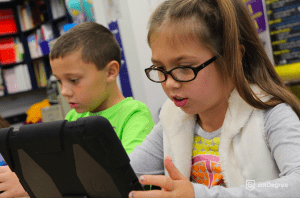Programming for Kids – How to Raise a Developer
This is a writeup on a recent article in BitDegree entitled “Programming for Kids: Why It’s Worth It and How To Approach It“.
Did you ever consider exposing your kids to programming lessons?
It’s no secret: parents only want the best for their child – and this does not end with comfortable clothes and filling meals. The ultimate goal is to give them a solid foundation in life. One of the best things you can do for your little ones is to provide them with a quality education that will allow them to pursue a career of their dreams. In the last few years, programming for kids has been in the spotlight – let’s discuss why and how you yourself could be teaching your kids to code!
The future of the IT world
Some people are skeptical about the hype of programming for kids. They believe you can never be sure what the future brings. However, it requires very little research to see that coding is not going away anytime soon. The sooner you start your child, the stronger he or she will stand.
The career choice of tomorrow

Gone are the days when coding was just a niche for geeky outcasts
Nowadays, professional developers are highly sought after in most companies. The international tech giants employ thousands every year – and they’re still experiencing a shortage! It seems as though everybody needs software, and every software program needs updates and support.
The opportunities aren’t limited to tech companies, either: two out of every three computing jobs are found in finance, business, healthcare, design, and a variety of other areas. It’s no wonder that a lot of parents are looking into programming for kids: a solid foundation means a stronger skill set, and this can turn into a guaranteed career.
The world is going IT-crazy – and programming is now considered a skill worth teaching universally
The world has been going IT-crazy for quite a while now – actually, long enough for programming to be considered a skill worth teaching universally. Apple’s CEO Tim Cook says “coding should be required in every public school in the world” and even states that it could be more important for kids to learn to code than to learn English as their second language. The parents seem to agree: a whopping 93 percent of them think teaching kids to code is a great way to use the school’s resources, and 91 percent want their children to learn more computer science. We can see the IT job – and teaching kids to code have one thing in common: the demand is far higher than the supply. Luckily, there’s lots of ways for kids to learn programming that don’t require the formal school environment… or even don’t require reaching school age.
Did you ever consider exposing your kids to programming lessons?
It’s no secret: parents only want the best for their child – and this does not end with comfortable clothes and filling meals. The ultimate goal is to give them a solid foundation in life. One of the best things you can do for your little one is to provide them with a quality education that will allow them to pursue a career of their dreams. In the last few years, programming for kids has been in the spotlight – let’s discuss why and how you could be teaching kids to code yourself!
The future of the IT world
Some people are skeptical about the hype of programming for kids. They believe you can never be sure what the future brings. However, it requires very little research to see that coding is not going away anytime soon. The sooner you start your child, the stronger he or she will stand.
The opportunities aren’t limited to tech companies, either: two out of every three computing jobs are found in finance, business, healthcare, design, and a variety of other areas. It’s no wonder that a lot of parents are looking into programming for kids: a solid foundation means a stronger skill set, and this can turn into a guaranteed career.
With the right approach, it’s even possible to teach basic coding for toddlers. Concentrate on GAMES – Coding Apps for Kids
If you, an adult person, wanted to start training in software development yourself, you would probably know where to start. There are university programs, online courses, bootcamps, tutorials, study guides, and a ton of other ways to get into this. However, if the child can still count his or her age on their fingers, it’s safe to say you can throw all of these out of the window. It is simply unrealistic to expect a small child to have an attention span or the patience of an adult. With the right approach, however, it’s even possible to teach basic coding for toddlers.
Move the Turtle
A lot of parents say their kids are fans of their iPads and other tablet computers. If it seems impossible to beat their fascination, don’t overdo it. With special coding apps for kids aged four and up, this entertainment machine can become a handy learning tool. Move the Turtle is a great option for anyone who wishes to introduce their youngsters to programming for kids. It uses the Logo programming language, which has been specially designed for educational purposes. As the name of the app suggests, the child can move the turtle around their iPad screen using various programming instructions. Each new level brings a different challenge that makes your child gradually but firmly grasp the concepts of variables, procedures, loops and conditional instructions. Instructions for Move the Turtle are published in English, Spanish or Polish.
Daisy the Dinosaur
If dinosaurs are more up your kid’s alley, introduce them to Daisy the Dinosaur. A simple drag and drop interface lets you animate the creature, make it spin, roll, jump, and even dance – while secretly teaching kids to code at the same time. Four-year-olds and older children will intuitively get how objects, sequences, events, and loops work. The downside to Daisy the Dinosaur is that it doesn’t offer many functions and challenges. However, as a free app, it can be a great introduction to programming for kids.

Hopscotch
This is another creation of the team behind Daisy the Dinosaur. Unlike the coding apps for kids mentioned before, this one is aimed at kids who are a bit older. Hopscotch can be used to teach coding for elementary students aged seven and up, both at home and in the classroom. By using the Scratch programming language, it simplifies game development for kids. As of now, there are 33 million games around the world that have already been created by children using Hopscotch!
Online programming games for kids
Applications for tablets are a great choice when you need to explain coding to slightly older kids. They do a pretty good job of introducing the basic concepts. However, introducing actual programming languages for kids requires more than a touch screen device and some drag-and-drop challenges. If your kid is a bit older (say, 7+) and already knows how to read and do some basic typing, you might want to show them some programming games for kids that can be played in any web browser. One of our personal favorites is CodeCombat, which offers a wide choice of disciplines to teach kids web development and game development. Going through levels and challenges of increasing difficulty, CodeCombat teaches programming languages for kids of all ages. Depending on the goal you choose, you can master HTML, CSS, JavaScript, Python, and others.
CodeMonkey
Another nice option for kids over ten years of age is CodeMonkey. In the game, you help the adorable little monkey collect bananas by completing various tasks. CodeMonkey can be used to teach CoffeeScript and Python programming languages. For kids, it is a great way to get a firm grasp on universal coding concepts, such as objects, arguments, variables, loops, and arrays. CodeMonkey is available in twenty languages.
Robot Turtles
Turn coding into a child’s play with specialized toys
Some parents feel hesitant about programming for kids because they think it means they will be spending hours and hours in front of the screen. You might be surprised to learn it might not even be necessary! First released in 2014 on Kickstarter, Robot Turtles is still the highest selling board game on the platform. Yes, you heard us right – it’s a game with a board, cards, and a few types of tiles that can be played by a company of up to five players. Created by a professional software developer and a father of young twins, Robot Turtles introduces programming concepts in a way that even a four-year-old can comprehend. By moving their turtles across the game board to avoid the obstacles and reach the diamond, your children can learn about basic commands, programs, functions, and debugging.
SmartGurlz – a series of four racially diverse programmable dolls for girls
The gender gap in the tech industry is immense: statistics say women occupy less than 18 percent of all the coding jobs. Luckily, thanks to a bunch of active women, inclusivity is on the rise – and you can see it in programming for kids, too. In this game, recommended by Girl Scouts of America and BlackGirlsCode, each doll has a scooter that you can control using the SugarCoated app. Your kids will carry out various missions – all while learning to code in Scratch. Basic algorithms, loops, and code sharing can literally be a child’s play!
Programming books for kids
It’s standard to imagine books and tech as two opposing sides, right? And yet it shouldn’t be. Both of these worlds can coexist and even intermingle to create the best result. As a matter of fact, programming books for kids can be a great way to introduce them to the world of coding.
Hello Ruby; Rails Girls – Storylines that intrigue
Just like Robot Turtles, Hello Ruby started as a Kickstarter project in 2014. As of 2022, the first book has been translated to over twenty languages, and three more have been published in the series. The author of the books is Linda Liukas – the founder of Rails Girls, an international program of coding workshops for women and girls. Hello Ruby doesn’t actually teach any programming languages for kids. Instead, it aims to make the key concepts of coding familiar to 5–7-year-olds. By following Ruby and her friends in their adventures, your little ones can grasp the idea of algorithms, patterns, debugging, variables, loops, and so much more.

Girls Who Code. How to Code a Sandcastle and How to Code a Rollercoaster
Apart from being a C++, Java, and Python developer, the author, Josh Funk, writes children’s books. He has also written two as a collaboration with the nonprofit organization Girls Who Code. How to Code a Sandcastle and How to Code a Rollercoaster tell the story of two friends: a girl named Pearl and a robot called Pascal. They introduce the steps of software development by building real-life objects. Boys and girls can grasp the proper sequence, loops, if statements, variables, and more. With humor and beautiful illustrations by Sara Palacios, the books are a delightful option for anyone who’s interested in programming for kids.
Coding Books – Books that provide instructions on how to create something – kids get hooked on web and game development
Max Wainewright’s books (link: Books by Max Wainewright) and The Young Rewired State community’s (link: getcodingkids.com), on HTML, CSS, and JavaScript for kids to get hooked on web and game development.
Some kids might find storytelling unnecessary: they want to get their hands onto action as soon as possible. It’s especially true for kids who are a bit older and more self-dependent. In such cases, you can choose books that provide instructions on how to create something. The Young Rewired State community has released, you can also take a look at the Dummies Junior book series. They contain all the fundamentals of specific programming languages for kids.
Teaching kids to program their future also teaches them to develop thinking skills
You might try all the tools described and all we still don’t know about, and your kid might still choose another career path when they grow up. Does that mean you failed? Absolutely not. Our goal is never to make kids live our dreams: they have to build and live theirdreams. All we can do is provide them the best foundations. Programming for kids is never just about a chance to push them towards a tech career. But rather, it is all about teaching them to think. Even the basic coding tasks will help your little one develop stronger organizational skills, teach them to solve problems, think outside the box and find shortcuts. Dealing with challenges of varying difficulty, they will be able to unleash their creativity and be as curious as can be. Most importantly, they will gain confidence in themselves. Because if they can make a robot dance with just a few lines of code – is there anything they cannot do?
This article also features a very helpful section on evaluating learning platforms:
Best Online Learning Platforms 2022: MOOC Reviews & Ratings (bitdegree.org)

###############################
We hope you have enjoyed our writeup on the article in BitDegree entitled
“Programming for Kids: Why It’s Worth It and How To Approach It “. Please drop us a line and let us know if the suggestions offered were helpful to you and your family.
###############################
Other brain games can be found under the heading “See Our Blogs”, by clicking any of the published blogs on the pages for the following categories:
“Brain Games For Children”
“Brain Games For Adults”
“Brain Games For Seniors”
“Advanced Brain Training”
“Optimal Brain Health”


